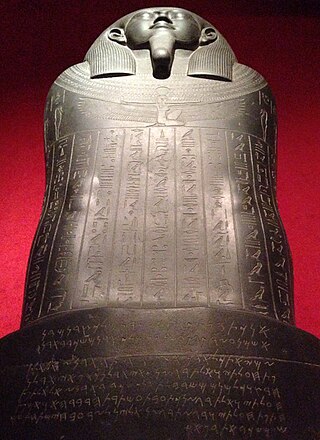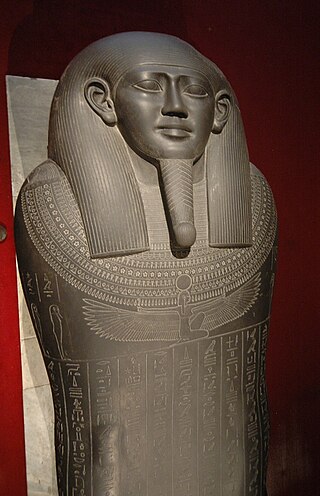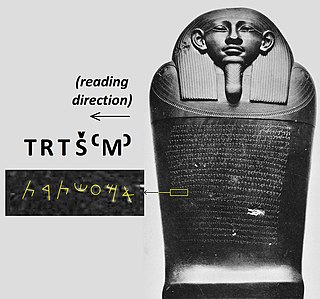Related Research Articles
The King of Tyre was the ruler of Tyre, the ancient Phoenician city in what is now Lebanon. The traditional list of 12 kings, with reigns dated to 990–785 BC, is derived from the lost history of Menander of Ephesus as quoted by Josephus in Against Apion I. 116–127. Josephus asserts that Menander had drawn his list from the chronicles of Tyre itself. Menander-Josephus also contains a list of 9 kings and judges, with reigns dated to 591–532 BC in Against Apion I. 154–160.

The sarcophagus ofEshmunazar II is a 6th-century BC sarcophagus unearthed in 1855 in the grounds of an ancient necropolis southeast of the city of Sidon, in modern-day Lebanon, that contained the body of Eshmunazar II, Phoenician King of Sidon. One of only three Ancient Egyptian sarcophagi found outside Egypt, with the other two belonging to Eshmunazar's father King Tabnit and to a woman, possibly Eshmunazar's mother Queen Amoashtart, it was likely carved in Egypt from local amphibolite, and captured as booty by the Sidonians during their participation in Cambyses II's conquest of Egypt in 525 BC. The sarcophagus has two sets of Phoenician inscriptions, one on its lid and a partial copy of it on the sarcophagus trough, around the curvature of the head. The lid inscription was of great significance upon its discovery as it was the first Phoenician language inscription to be discovered in Phoenicia proper and the most detailed Phoenician text ever found anywhere up to that point, and is today the second longest extant Phoenician inscription, after the Karatepe bilingual.

The Temple of Eshmun is an ancient place of worship dedicated to Eshmun, the Phoenician god of healing. It is located near the Awali river, 2 kilometres (1.2 mi) northeast of Sidon in southwestern Lebanon. The site was occupied from the 7th century BC to the 8th century AD, suggesting an integrated relationship with the nearby city of Sidon. Although originally constructed by Sidonian king Eshmunazar II in the Achaemenid era to celebrate the city's recovered wealth and stature, the temple complex was greatly expanded by Bodashtart, Yatonmilk and later monarchs. Because the continued expansion spanned many centuries of alternating independence and foreign hegemony, the sanctuary features a wealth of different architectural and decorative styles and influences.

Eshmunazar II was the Phoenician king of Sidon. He was the grandson of Eshmunazar I, and a vassal king of the Persian Achaemenid Empire. Eshmunazar II succeeded his father Tabnit I who ruled for a short time and died before the birth of his son. Tabnit I was succeeded by his sister-wife Amoashtart who ruled alone until Eshmunazar II's birth, and then acted as his regent until the time he would have reached majority. Eshmunazar II died prematurely at the age of 14. He was succeeded by his cousin Bodashtart.

Bodashtart was a Phoenician ruler, who reigned as King of Sidon, the grandson of King Eshmunazar I, and a vassal of the Achaemenid Empire. He succeeded his cousin Eshmunazar II to the throne of Sidon, and scholars believe that he was succeeded by his son and proclaimed heir Yatonmilk.

The Tabnit sarcophagus is the sarcophagus of the Phoenician King of Sidon Tabnit, the father of King Eshmunazar II. It is decorated with two separate and unrelated inscriptions – one in Egyptian hieroglyphs and one in the Phoenician alphabet. The latter contains a curse for those who open the tomb, promising impotency and loss of an afterlife.

Tabnit was the Phoenician King of Sidon c. 549–539 BC. He was the father of King Eshmunazar II.

Abdashtart I was a king of the Phoenician city-state of Sidon who reigned from 365 BC to 352 BC following the death of his father, Baalshillem II.

Tennes was a King of Sidon under the Achaemenid Empire, who ruled the Phoenician city-state of Sidon from, having been associated in power by his father since the 380s. It remains uncertain whether his known heir and successor, Tennes, was his son or some other close relative. His predecessor was Abdashtart I, the son of Baalshillem II
Belesys II was the ruler of Achaemenid Syria as the satrap of Eber-Nari from 358–338 BCE.

The first Achaemenid conquest of Egypt took place in 525 BCE, leading to the foundation of the Twenty-seventh Dynasty of Egypt, also known as the "First Egyptian Satrapy". Egypt thus became a province (satrapy) of the Achaemenid Persian Empire until 404 BCE while still maintaining Egyptian royalty customs and positions. The conquest was led by Cambyses II, the King of Persia, who defeated the Egyptians at the Battle of Pelusium, and crowned himself as Pharaoh of Egypt. Achaemenid rule was disestablished upon the rebellion and crowning of Amyrtaeus as Pharaoh. A second period of Achaemenid rule in Egypt occurred under the Thirty-first Dynasty of Egypt.
Yatonmilk was a Phoenician King of Sidon, and a vassal to the Achaemenid king of kings Darius I.

The Bodashtart inscriptions are a well-known group of between 22 and 24 Phoenician inscriptions from the 6th century BC referring to King Bodashtart.

The Baalshillem Temple Boy, or Ba'al Sillem Temple Boy, is a votive statue of a "temple boy" with a Phoenician inscription known as KAI 281. It was found along with a number of other votive statues of children near the canal in the Temple of Eshmun in 1963-64 by Maurice Dunand, and is currently in the National Museum of Beirut.
Tetramnestos was, according to Herodotus, a King of Sidon who assisted the Achaemenid Emperor Xerxes I in the Second Persian invasion of Greece in 480 BCE. Specifically, he is said to have served as the chief advisor of Xerxes in naval matters. In effect, the Sidon fleet held a position of primacy among the naval forces of the Achaemenid Empire at that time, providing the best ships in the fleet, superior even to the fleet of Artemisia of Halicarnassus. The Phoenicians furnished a fleet of 300 ships, "together with the Syrians of Palestine".
Eshmunazar I was a priest of Astarte and the Phoenician King of Sidon. He was the founder of his namesake dynasty, and a vassal king of the Achaemenid Empire. Eshmunazar participated in the Neo-Babylonian campaigns against Egypt under the command of either Nebuchadnezzar II or Nabonidus. The Sidonian king is mentioned in the funerary inscriptions engraved on the royal sarcophagi of his son Tabnit I and his grandson Eshmunazar II. The monarch's name is also attested in the dedicatory temple inscriptions of his other grandson, King Bodashtart.

Baalshillem I was a Phoenician King of Sidon, and a vassal of the Achaemenid Empire. He was succeeded by his son Abdamon to the throne of Sidon.
Baalshillem II was a Phoenician King of Sidon, and the great-grandson of Baalshillem I who founded the namesake dynasty. He succeeded Baana to the throne of Sidon, and was succeeded by his son Abdashtart I. The name Baalshillem means "recompense of Baal" in Phoenician.

Amoashtart was a Phoenician queen of Sidon during the Persian period. She was the daughter of Eshmunazar I, and the wife of her brother, Tabnit. When Tabnit died, Amoashtart became co-regent to her then-infant son, Eshmunazar II, but after the boy died "in his fourteenth year", she was succeeded by her nephew Bodashtart, possibly in a palace coup. Modern historians have characterized her as an "energetic, responsible [woman], and endowed with immense political acumen, [who] exercised royal functions for many years".

Abdamon (also transliterated Abdamun ; Phoenician: 𐤏𐤁𐤃𐤀𐤌𐤍, was a Phoenician King of Sidon, and a vassal of the Achaemenid Empire. He was succeeded by his son Baana to the throne of Sidon.
References
Citations
- 1 2 3 Eiselen 1907, pp. 155–156.
- ↑ Sayce 1893, p. 241.
- ↑ Bordreuil & Gubel 1986, p. 434.
- 1 2 3 4 5 6 7 8 Elayi 2006, p. 22–32.
- ↑ Kelly 1987, p. 42.
- 1 2 Heckel 2008, pp. 16–17.
Sources
- Bordreuil, Pierre; Gubel, Eric (1986). "Bulletin d'antiquités archéologiques du Levant inédites ou méconnues". Syria. Archéologie, Art et histoire. 63 (3): 417–435. doi:10.3406/syria.1986.6956.
- Eiselen, Frederick Carl (1907). Sidon : a study in oriental history. University of California Libraries. New York : Columbia University Press.
- Elayi, Josette (2006). "An updated chronology of the reigns of Phoenician kings during the Persian period (539–333 BCE)" (PDF). Digitorient. Collège de France – UMR7912. Archived from the original (PDF) on 2020-07-30.
- Heckel, Waldemar (2008). Who's Who in the Age of Alexander the Great: Prosopography of Alexander's Empire. John Wiley & Sons. ISBN 978-1-4051-5469-7.
- Kelly, Thomas (1987). "Herodotus and the Chronology of the Kings of Sidon". Bulletin of the American Schools of Oriental Research. 268: 39–56. doi:10.2307/1356993. ISSN 0003-097X.
- Sayce, LLD. (1893). "The Phoenician inscriptions on the vase handles found at Jerusalem" (PDF). Palestine Exploration Fund Quarterly Statement. 25: 240–242. Archived (PDF) from the original on 29 October 2023.